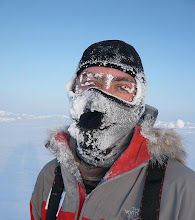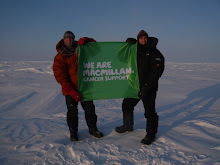So, below is a guide to extreme Polar exploration and a sample of what a typical day is going to look like, courtesy of Doug Stoup, expedition leader, who's achievements ou can check out here:
When & How
Departure from Longyearbyen (in Svalbard - off the northern tip of Norway) will be in the morning. The plane will be a Russian Antonov 74. This is a short-runway jet with a carrying capacity of around thirty people. We will land at "Borneo" (a drifting Russian ice-station set up in advance each year) situated at about 89 degrees North. Borneo is re-established each year by Russian staff from Khatanga in Siberia. Because thick, frozen leads are used for the runway, the position of Borneo varies from year to year. Three hours after leaving Longyearbyen we will land at Borneo. Time of arrival into Borneo and weather conditions permitting we plan to set out from the base that same day. This allows us to get out into the pack-ice and into our routines without further delay.
The final degree of latitude spans roughly 110 kilometres from the 89th parallel to the Geographic North Pole. The first couple of days will be heavy going. Gradually our bodies will acclimatize and we will adapt to the conditions and terrain and our speed and distance covered each day will increase.
Once we reach the pole, we will be picked up in a MI-8 helicopter. We will have a little over a week to reach the pole. Past expeditions show that this is adequate to cover the last degree on skies. However, as ice conditions vary from year to year, it is important to have a safety margin. We will probably have one day in hand before pick up, depending on when we reach the North Pole.
A Typical Day on the Ice
On departure from Borneo we will encounter light twenty-four hours a day with temperatures between -25° and -35°C. The landscape will be fascinating and ever-changing. As we navigate our way through leads and pack-ice, our surroundings will vary constantly and never become monotonous. The midnight sun, the pack-ice and the special quality of light I'm told will infect most people with the Polar Bug, a lifelong and incurable affliction.
Alarm will be set for 06.00. Lighting the stove is simple, but melting snow for water takes time at minus 30°C. We will take turns in preparing food and water. If it's not my turn to prepare food that day, I'll be able to have an extra hour's sleep in my sleeping bag before I need to worry about breakfast and filling the thermos flasks with water.
Packing up equipment and tents; gradually this will become routine, we will agree a time for departure and each tent will manage its time accordingly. It actually takes two and a half to three hours from “wake up" to the moment when we're standing in front of our sleds and ready to go.
Skis on, ready to leave. The day consists of 8-10 hours on skis with regular breaks. every 1 hr 15 mins. We will be eating a calorie-rich diet throughout the day. One of the most important things is to keep on the move, not get cold, so consequently breaks are short. Even so, I'll have plenty of photo opportunities during the march, at each ice ridge and lead we have to force.
We will be moving across a frozen sea, with 4,000 meters of water beneath us. This is what makes the polar environment so unique. Throughout the day we will cross a mixture of ice fields, pack-ice, thin ice and leads. Pack-ice is the most common, it will slow us down and can be tough to negotiate, and for that reason the daily stages are shorter than would be normal in winter mountain travel further south.
Evening. The first task is to use one's experience to find a secure camping place, where the ice won't begin to pack or open up just where we have set up our camp. We shall be living in two- or three-man tents. Again, the snow-melting takes a long time, we need to melt about four litres per person per day, but it's always a joy to get into the tent in the evening and feel the warmth of the stove. Dinner is the high point of the day, consisting of good, rich expedition food that will warm us up. I'm told nothing is nicer than to go to sleep happy and replete after a good day's work in the pack-ice. With the sleeping bags we'll be using no one will feel cold. Most people will sleep soundly and awake next morning refreshed and ready for new challenges.
Our safe arrival at the Geographic North Pole is our goal. On arrival at the North Pole there will be time to celebrate, take photographs and contemplate where we are in the world and a thought for my Dad and all those amazing people who have helped me to get there. I'm sure there'll be a tear in my eye when I do get there. Hopefully my eyes won't freeze shut.
We will be picked up by helicopter from the North Pole and flown back to Borneo. Again weather and runway conditions permitting. There is a possibility, though slim that we will overnight at the North Pole. Departure to Longyearbyen from Borneo is generally in the evening. We will not be able to confirm this until after our arrival the North Pole.
Once airborne, two and a half hours later we'll be back in "civilization" at Longyearbyen.
So, it should be a doddle!!







No comments:
Post a Comment